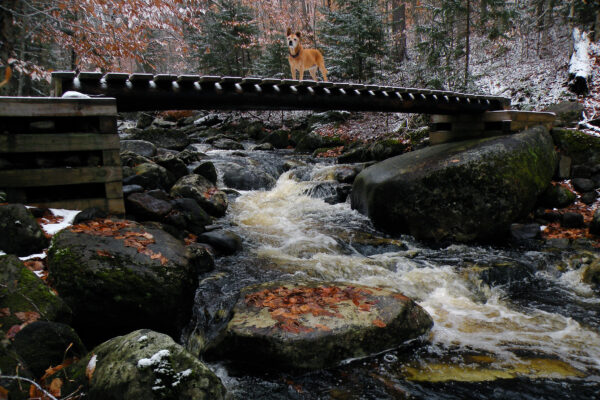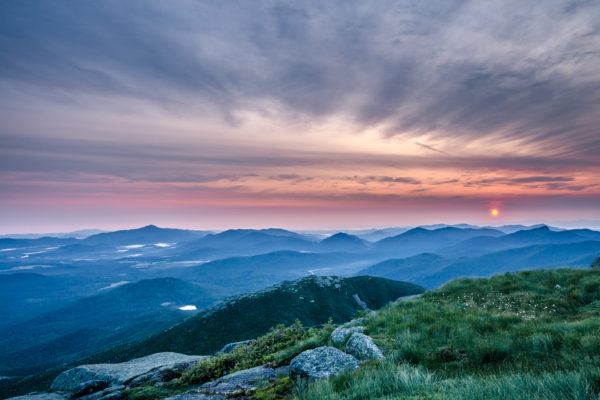By all accounts, it takes effort to get to the summit of Mt. Marcy. Even the easiest route to the top of New York State demands an exhausting climb up thousands of feet in elevation, clambering mile after mile along puddle-pocked, root- and rock-ridden trails, through disorientingly thick woodlands and over exposed anorthosite slabs. No amount of preparation, conditioning, or top-notch gear can fully prevent sore feet and aching knees, the occasional wrong turn, scrape, or stumble. Add to that hunger, thirst, tinges of fear and doubt. Black flies in the summer. Darkness in the winter. Rain, snow, wind, sun.
But oh, the beauty! The joy!
I can’t speak for the thousands of others who trek into the heart of the High Peaks Wilderness each year, but I suspect that they venture into the forest and mountains seeking similar things—adventure, challenge, rediscovery of or reconnection with a place bigger and wilder than our individual lives. I also can’t speak for what others find in the wilderness, but I suspect that even if they don’t make it to the very top of Mt. Marcy or arrive only to find themselves shrouded in thick mist, they still learn a great deal about themselves and the humbling scale of the non-human world. Lastly, I can’t speak for what others take from their hike, but I suspect that they remember the experience—as something to be proud of or something to rue, something that makes a fundamental shift in their sense of self and inspires them to spend the rest of their life exploring and absorbing wild places. Something that makes them want to see these places kept intact as wilderness, where natural processes dominate, ecosystems flourish, and generations of women and men come for adventure, challenge, discovery, and delight.

That’s why I go. After three seasons of working as a High Peaks Summit Steward—spending each day hiking up to the top of Mt. Marcy or Algonquin or Wright to protect the rare and fragile Arctic-Alpine vegetation and speak with visitors—I can’t say that I exactly enjoy the commute up and down. (Trees make me feel claustrophobic. Trails make me feel constrained. I’ve worn through three pairs of Bean boots.) I do, though, love the perspective it affords. By that, I mean I love the actual view from 5,344 feet—peak after peak, blueing with distance; valley after valley, shimmering with lakes. (When away from the mountaintop, I can close my eyes and feel the landscape in front of me, it’s so deeply seared into my soul.) But I also love the perspective the peaks give to my life: knowledge that I can plan for and tough it out through physically and emotionally demanding circumstances; appreciation for the soft comforts and luxuries (not the tameness and trammeledness) of modern society; marvel at the wonder, the beauty, and the sheer joy of sunlight glinting off labradorite, sandwort exploding into bloom, white-throated sparrows whistling from the krummholz, thunderstorms building and breaking, mist writhing and swirling and lifting to reveal the rest of the wonder-full, marvelous world.
Sometimes when hikers meet me at the top, they ask, “Aren’t you afraid to be out alone in the wilderness?” I’m never sure how to respond. Do I paraphrase John Muir, insisting that I’m one of the “thousands of tired, nerve-shaken, over-civilized people [who has found out] that going to the mountains is going home; that wildness is a necessity”? Or do I insist that I am, like Aldo Leopold, one who simply cannot “live without wild things”? Do I launch into my entire biography—discovery of wilderness in the great open sagebrush-steppe of Arizona; an immediate sense of belonging; subsequent forays into ever greater, ever wilder plains, mountains, canyons, forests; more than ten years wandering the wild corners of Wyoming, Colorado, Alaska, now New York? How do I tell them that I actually feel more competent, more alive on a mountaintop than in a classroom or grocery store?
“No,” I usually reply, “I love it here.” By that, I mean: the beauty, the joy! (Less so, the black flies.)
Normally, I don’t speak of Mt. Marcy in such personal terms. When discussing the need for wilderness areas, I usually prioritize ecological concerns—wilderness as refugia for declining species; wilderness as benchmarks for environmental change—then recreational and economic benefits. It seems both squishy and stuffy to tout geographic theories of “place-identity” and “topophilia”, to discuss how wilderness preservation can not only mitigate ecological deterioration, but prevent the spread of solastalgia—a feeling of tremendous loss and pain people feel when witnessing anthropogenic environmental change. But (as phenomenologists remind us), we experience the world through our senses, as individuals with different sets of memories and dreams. Everyone who makes the trek up and down Mt. Marcy may not see and feel exactly the same things, but we share a sense of distance and elevation, sore feet, strong winds, wildness.
One last quote, from Gary Snyder: “To know the spirit of a place is to realize that you are a part of a part and that the whole is made of parts, each of which is a whole. You start with the part you are whole in.” I am whole in the High Peaks, I am alive there. I want to keep that spirit intact, as wilderness. I suspect others feel the same way.



